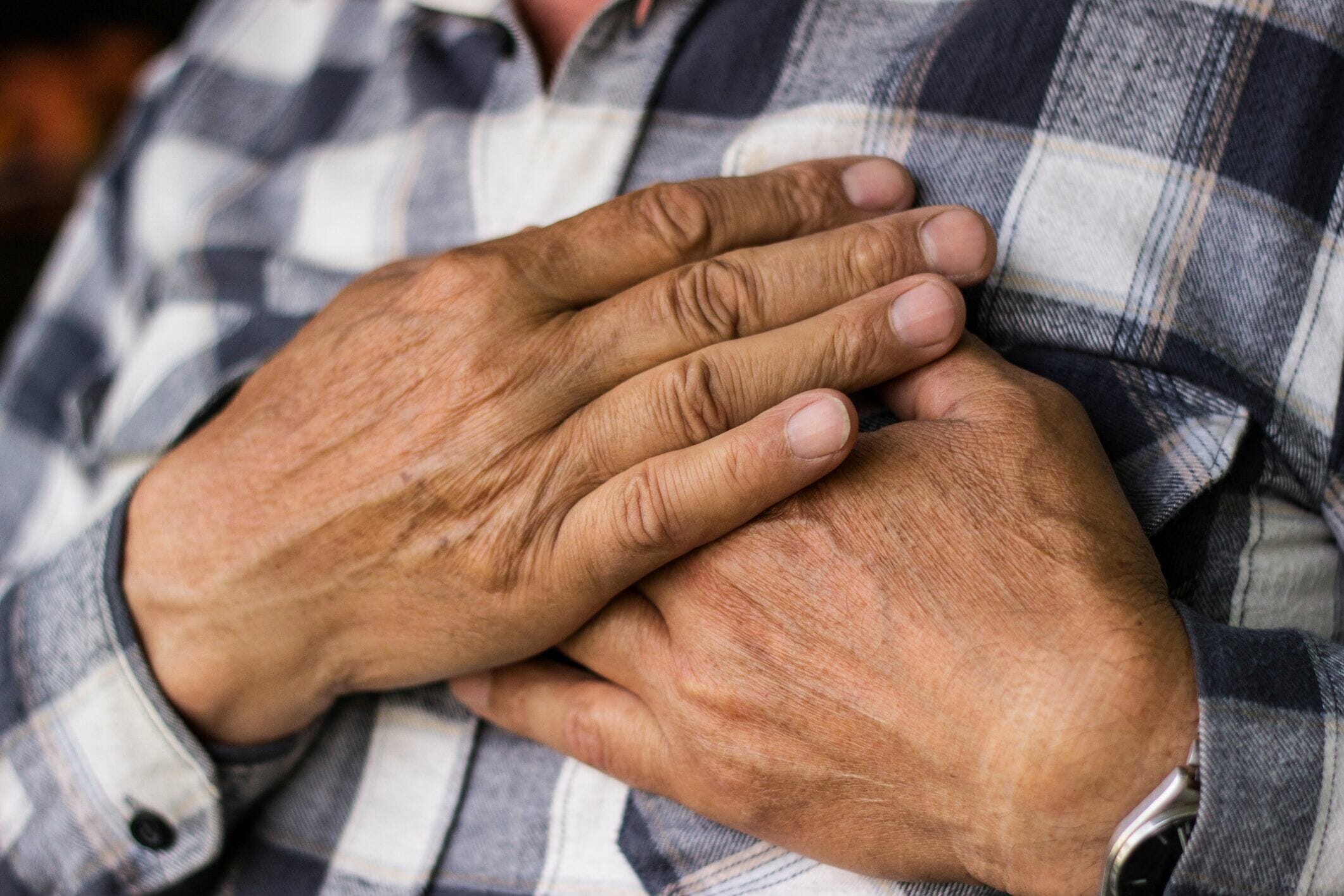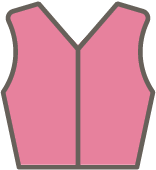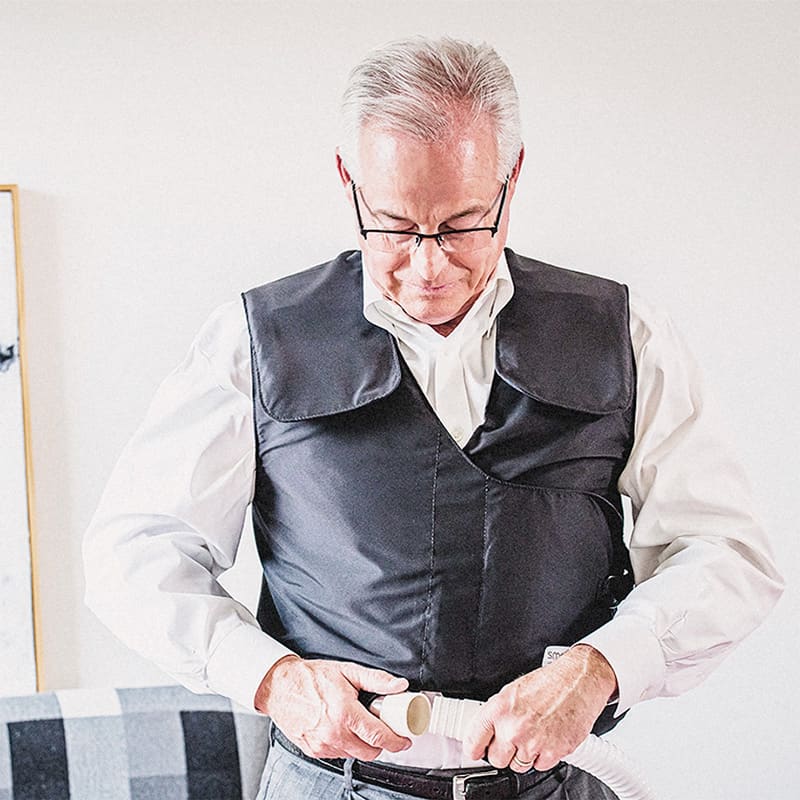
Chest Physiotherapy (CPT) is an airway clearance technique that typically involves the assistance of another individual (e.g., caregiver, trained family member, or respiratory therapist) to manually perform chest percussion on a patient’s chest wall.
Chest percussion is defined as manually clapping on a person’s chest wall in an effort to break up mucus and prevent buildup. For this technique to be effective, however, clapping must be performed in a repeated and rhythmic beat sequence to create vibrations that help move mucus from the smaller airways to larger ones, where it is more easily coughed out.¹
In this article, you’ll find a comprehensive overview on the different types of chest physiotherapy, their benefits, and how they work to improve airway clearance in patients living with chronic lung conditions.
Topics we’ll cover include:
What Causes Airway Obstruction?
How to Perform Percussion Vest Therapy
Manual CPT vs. Percussion Chest Vest Therapy
Which Option Is Right for You?
Chest Physiotherapy 101
Sometimes referred to as chest physical therapy, CPT describes not one but a group of treatments designed to help patients improve respiratory function and prevent airway obstruction.²
For instance, chest physical therapy is often accompanied by vibrations (also used to help dislodge mucus) and postural drainage. Postural drainage is a technique that relies on gravity to allow patients to drain mucus from different areas of the lungs into the mouth.
Combining chest percussion with vibrations and postural drainage can help break up and move mucus upward, where it’s easier to expel from your airways.
Understanding Your Airways
Before we dive further into this topic, let’s first review how our airways work and what happens when they experience obstruction.
Your airways are composed of a trachea (i.e., windpipe), bronchial tubes, lungs, pharynx (throat), mouth, and nose. They also require the assistance of respiratory muscle groups, such as your diaphragm, to deliver air in and out of your lungs, as well as cilia to help swipe away dust, germs, and airborne irritants.³
When airways experience inflammation in the lungs—a natural reaction to the exposure of germs and other irritants—breathing becomes more difficult.
“Inflammation happens when a physical factor triggers an immune reaction. Inflammation does not necessarily mean that there is an infection, but an infection can cause inflammation.”4
Although a natural defense mechanism to help fight infection, inflammation can cause the airways to narrow and the muscles surrounding it to tighten. When our airways become obstructed, we may experience coughing, wheezing, and shortness of breath.5
As a result, mucus builds up in our lungs, resulting in infection. Thus, starting the inflammation cycle all over again.
Causes of Airway Obstruction
Living with a chronic lung condition, such as chronic obstructive pulmonary disease (COPD), bronchiectasis, asthma, or cystic fibrosis (CF), can cause a person to experience airway obstruction.
Bronchiectasis, for example, develops after repeated damage to the lungs and airways, due to frequent respiratory infections. However, unlike asthma, a condition that causes the airways to become inflamed, narrowed, and disrupting the body’s natural flow of oxygen,6 bronchiectasis causes the airways to become abnormally widened.
In doing so, the lungs slowly lose their ability to mobilize and clear mucus on their own. The result is mucus buildup (i.e. airway obstruction), which then becomes a breeding ground for bacteria, viruses, or fungus within the lungs.
With each condition, any damage done to the lungs is irreversible, and with each cycle of infection, symptoms can worsen and require hospitalization.
How Does Chest Physiotherapy Work?
Now that we know how and why airway obstruction occurs, let’s review how airway clearance techniques, like CPT, can help individuals find symptom relief.
As noted earlier, CPT describes a group of techniques performed in collaborations with one another to help prevent mucus buildup. However, it’s important to note that this type of therapy can be performed in one of two ways:
- Manual Chest Physiotherapy (Manual CPT)
- Percussion Vest Therapy
How Is Manual CPT Performed?
Manual CPT is typically performed in the comfort of a patient’s home. While lying in various positions, a caregiver, family member, or respiratory therapist will manually clap on a person’s chest wall: “Clapping (percussion) by the caregiver on the chest wall over the part of the lung to be drained helps move the mucus into the larger airways.”7
By cupping the hand to help soften the clapping movement, the person performing CPT will repeatedly clap the chest, using a steady, even beat. After a series of percussion is completed, the caregiver will use a steady hand to create a shaking motion to help form vibrations in the lungs.
As noted earlier, this technique is often followed by postural drainage. The caregiver will have the patient sit or lie down in various positions to allow gravity to move the mucus toward the mouth.
How Often Is Manual CPT Performed?
As each person is different, the frequency with which chest percussion therapy is performed, as well as its duration, will vary. However, on average, it can take up to 20-40 minutes to complete, from beginning to end.
The percussion (clapping), itself, typically takes about 3-5 minutes for each part of the lung it’s trying to drain. Following the clapping movement, the caregiver will then flatten his or her hand on the patient’s chest wall over the area that is being drained. The caregiver will then apply light pressure and create a shaking motion to cause vibration. This may last around 15 seconds.
Afterward, the patient is asked to cough forcefully to move the mucus out of the lungs.8
“With chest physical therapy (CPT), the person gets in different positions to use gravity to drain mucus (postural drainage) from the five lobes of the lungs. Each position is designed so that a major part of the lung is facing downward. When combined with percussion, it may be known as postural drainage and percussion (PD&P). This is where a caregiver or partner can clap and or vibrate the person’s chest to further dislodge and move the mucus to the larger airways where it can be coughed or huffed out of the body.”9
How Is Percussion Vest Therapy Performed?
Utilizing high frequency chest wall oscillation (HFCWO) therapy, patients wear an inflated vest that delivers recurring pulses of air that squeeze and release their upper body, loosening and thinning mucus from the lungs, so it’s more easily coughed up.
Though we cannot speak for every percussion vest on the market, we can tell you that the SmartVest Airway Clearance System works like this:
Patients will put on their HFCWO therapy garment that fits comfortably around the shoulders and chest wall, using Velcro-like closures. The vest includes a single-hose connector that connects to its generator.
During therapy, the garment gently squeezes and releases the chest wall, creating rapid air movement throughout the lungs, which causes mucus to be sheared away from the lining of the airways and become thinner. The oscillation makes it easier for mucus to be propelled upward, where it is more easily coughed out.
As with Manual CPT, coughing, or “huff cough”, is paired with HFCWO therapy, as it helps patients bring up loosened phlegm.
Performing huff cough is similar to how you would breathe on a pair of eyeglasses to clean them. The patient will begin by inhaling deeply through his or her nose. Then, while pulling in the abdomen area, the patient will force the air out through the mouth in three equal breaths—making a “huff” sound in the back of the throat. Though effective, this breathing technique takes practice and should be repeated 2-3 times.10
Manual CPT vs. Percussion Chest Vest Therapy
Though manual CPT and HFCWO therapy offer patients two effective approaches to clearing mucus, there are a few important differences between each.
Independence
 A key difference between manual CPT and HFCWO therapy is that the latter can be performed independently.
A key difference between manual CPT and HFCWO therapy is that the latter can be performed independently.
Manual CPT involves a series of steps (percussion, vibration, and postural drainage) that require assistance from another individual. Though it is possible to perform this therapy on your own in order to target the upper lobes of your lungs,11 this doesn’t provide 360° chest coverage. Therefore, you would need help reaching (and clapping) other areas of the chest wall.
Additionally, in order to be effective, manual CPT must be done forcefully and with a steady beat—multiple times a day.12 This can become uncomfortable and time consuming for both the patient and caregiver.
Though manual CPT and HFCWO therapy offer patients two effective approaches to clearing mucus, there are a few important differences between each.
More Independence with SmartVest
SmartVest allows airway clearance therapy to be performed independently. Though each person is different, on average, therapy can be performed 2x day (recommended morning and evening) for 20-30 minutes.
SmartVest users can safely and easily administer each therapy session by using a preset program on their generator. This ensures patients are staying on track with their prescribed therapy.
Users also do not need to lie down in various positions to effectively break up mucus. Instead, SmartVest delivers 360° chest coverage simultaneously. Therefore, you can perform therapy while enjoying an activity. This might include watching TV, hanging out with grandchildren, or playing a board game.
Comfort
 While performing manual CPT, the cupping of the hand is done to help reduce any discomfort on behalf of the individual receiving treatment, as well as the person performing treatment.
While performing manual CPT, the cupping of the hand is done to help reduce any discomfort on behalf of the individual receiving treatment, as well as the person performing treatment.
Nevertheless, this constant movement and switching of positions may cause discomfort and become tiring, especially if you must perform chest percussion therapy for longer periods, or at more frequent intervals.
In addition, caregivers must be careful not to clap the patient’s spine, breastbone, stomach, and lower back. Doing so may cause an injury or discomfort to vital organs, such as the kidneys or spleen.13
Better Comfort with SmartVest
SmartVest fills with air that begins to pulsate (squeezing and releasing your chest wall) at an adjustable frequency. With each compression, air moves through the airways of the lungs and moves mucus upward while treating all lobes of your lungs at the same time.
On average, SmartVest releases 91% of its air between compressions, creating more Breathing Room™ for patients. This ensures a more comfortable experience each therapy session.14
Efficacy
 According to an independent, retrospective cohort analysis,15 where data was collected and analyzed to assess the efficacy of HFCWO on non-cystic fibrosis bronchiectasis (NCFB) patients, the study revealed that before and after usage of HFCWO therapy, patients experienced:
According to an independent, retrospective cohort analysis,15 where data was collected and analyzed to assess the efficacy of HFCWO on non-cystic fibrosis bronchiectasis (NCFB) patients, the study revealed that before and after usage of HFCWO therapy, patients experienced:
- A decrease in hospitalizations, pneumonia, cough, and medication usage.
- A reduction in Healthcare Resource Utilization (HCRU) including having fewer chest x-rays, computerized tomography (CT) scans, and lung function tests.
Proven Results with SmartVest
Consistent with these results, findings from a previous 2019 first-of-its-kind, peer-reviewed study,16 published in BMC Pulmonary Medicine, found that when the SmartVest Airway Clearance System, a HFCWO therapy device, was utilized in an algorithm of care treatment plan, it helped patients experiencing the following benefits:
- Reduce bronchiectasis-related exacerbations requiring hospitalization
- Decrease antibiotic usage
- Improve lung stability16
Both studies reveal the long-term benefits to making HFCWO therapy a part of your treatment plan.
Choosing the Right Airway Clearance Therapy
New to airway clearance? If you’re living with a chronic lung condition, like COPD or bronchiectasis, breathing without feeling constricted in the airways is something you never want to take for granted.
Though your clinician may prescribe different types of treatments to help you manage your symptoms—such as antibiotics or mucus-thinning medications—airway clearance works to help treat the underlying cause of your chronic symptoms (i.e., mucus buildup). However, as you have learned from this article, there are different approaches to airway clearance. Therefore, it’s important to talk to your doctor about which technique is right for you, your condition, and your lifestyle.
SmartVest delivers a comfortable, effective treatment option that you can perform independently. To learn more about our HFCWO therapy device, request an information packet today. We’ll ensure the packet arrives right to your home. It will and include resources you can share with your healthcare team, including a prescription form to help you start your SmartVest journey!
If you’re ready to chat now to see if SmartVest is right for you, request a call with a Patient Care Advocates or call them directly at 1.855.528.5690!
Resources
[1] Cystic Fibrosis Foundation. “Chest Physical Therapy.” Retrieved from https://www.cff.org/managing-cf/chest-physical-therapy
[2] Encyclopedia.com. “Chest Physical Therapy.” Retrieved from https://www.encyclopedia.com/medicine/divisions-diagnostics-and-procedures/medicine/chest-physical-therapy
[3] Cleveland Clinic. “Respiratory System.” Retrieved from https://my.clevelandclinic.org/health/articles/21205-respiratory-system
[4] Medical News Today. “Everything You Need to Know About Inflammation.” Retrieved from https://www.medicalnewstoday.com/articles/248423
[5] John Hopkins Medicine. “Definition: Airway Obstruction.” Retrieved from https://www.hopkinsallchildrens.org/Patients-Families/Health-Library/HealthDocNew/Definition-Airway-Obstruction
[6] National Heart, Lung, and Blood Institute. “Asthma: Overview.” Retrieved from https://www.nhlbi.nih.gov/health-topics/asthma
[7] Cystic Fibrosis Foundation. ” Chest Physical Therapy.” Retrieved from https://www.cff.org/managing-cf/chest-physical-therapy
[8] Cystic Fibrosis Foundation. ” Chest Physical Therapy.” Retrieved from https://www.cff.org/managing-cf/chest-physical-therapy
[9] Cystic Fibrosis Foundation. ” Chest Physical Therapy.” Retrieved from https://www.cff.org/managing-cf/chest-physical-therapy
[10] American Thoracic Society. “Treating Bronchiectasis.” Retrieved from https://www.thoracic.org/patients/patient-resources/resources/bronchiectasis-treatment.pdf
[11] Cystic Fibrosis Foundation. ” Chest Physical Therapy.” Retrieved from https://www.cff.org/managing-cf/chest-physical-therapy
[12] Cystic Fibrosis Foundation. ” Chest Physical Therapy.” Retrieved from https://www.cff.org/managing-cf/chest-physical-therapy
[13] Cystic Fibrosis Foundation. ” Chest Physical Therapy.” Retrieved from https://www.cff.org/managing-cf/chest-physical-therapy
[14] Pokorney J. Comparison of Oscillatory Trough Pressure Generated by High Frequency Chest Wall Oscillation (HFCWO) Systems: A White Paper.
[15] DeKoven M, Mandia K, DeFabis N, Chen J, Ruscio A. Patient characteristics, healthcare resource utilization and outcomes among non-cystic fibrosis bronchiectasis patients with high frequency chest wall oscillation (HFCWO) therapy. IQVIA PharMetrics Plus for MedTech. 2018-2019
[16] Powner, J, et al. Employment of Algorithms of Care Including Chest Physiotherapy Results in Reduced Hospitalizations and Stability of Lung Function in Bronchiectasis. BMC Pulmonary Medicine, BioMed Central. 25 Apr. 2019.


